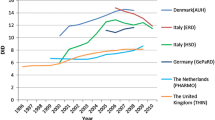Abstract
Objective
To evaluate antibiotic paediatric consumption data in the community setting using data from studies published between 2000 and 2005 and to compare inter- and intra-country antibiotic prescribing patterns.
Methods
A literature search was performed in EMBASE and MEDLINE to identify pharmacoepidemiological studies published between 2000 and 2005.
Results
Large differences between studies were found, with significant heterogeneity in epidemiological indicators. Only 20 studies reporting comparable drug prescription data were considered in the analysis, all of which were from the USA, Canada, North-Central Europe and Italy. Pre-school children were reported as comprising the most exposed age group to antibiotic therapy (prevalence 72%; prescription rate 2.2 prescriptions/person per year). In the overall child and adolescent population (≤19 years), prevalence varied from 14 to 57% (mean 34%), and the prescription rate from 0.2 to 1.3 prescriptions/person per year. Relevant inter-country qualitative and quantitative differences in antibiotic prescribing were apparent, although these were observed in only a few countries: prevalence was higher in Italy and Canada (prevalence range 42–57%) and lower in the Netherlands and the United Kingdom (prevalence range 14–21%). Penicillins were the most prescribed antibiotics in all cases (40–70% of antibiotic prescriptions), followed by macrolides (16–45%), while cephalosporins accounted for a large proportion of the prescriptions in Italy (30–40%) and Canada, but were practically absent in North European prescriptions.
Conclusion
Comparative drug utilisation studies on antibiotic use in children are needed, as are improvements in regulatory and educational programmes aimed at limiting the number prescriptions given for antibiotics. Both approaches would address public health problems, such as bacterial resistance and safety and elevated costs, related to the use and misuse of these drugs.

Similar content being viewed by others
References
Bowlware KL, Stull T (2004) Antibacterial agents in pediatrics. Infect Dis Clin North Am 18:513–531
Thrane N, Sørensen HT (1999) A one-year population-based study of drug prescriptions for Danish children. Acta Paediatr 88:1131–1136
Jacobs RF (2000) Judicious use of antibiotics for common paediatric respiratory infections. Ped Infect Dis J 19:938–943
Nyquist AC, Gonzales R, Steiner JF, Sande MA (1998) Antibiotic prescribing for children with colds, upper respiratory tract infections, and bronchitis. JAMA 279:875–877
World Health Organization (2005) The European Health Report 2005. Public health action for healthier children and populations. Available at: http://www.euro.who.int/document/ehr05/e87325_table7.pdf (last accessed 28 May 2007)
Kumar S, Little P (2003) Why do general practitioners prescribe antibiotics for sore throat? Grounded theory interview study. Br Med J 326:138–143
Linder JA, Bates DW, Lee GM, Finkelstein JA (2005) Antibiotic treatment of children with sore throat. JAMA 294:2315–2322
American Academy of Pediatrics and American Academy of Family Physicians (2004) Clinical practice guideline. Diagnosis and management of acute otitis media. Pediatrics 113:1451–1465
Marchetti F, Ronfani L, Nibali SC, Tamburlini G; Italian Study Group on Acute Otitis Media (2005) Delayed prescription may reduce the use of antibiotics for acute otitis media: a prospective observational study in primary care. Arch Pediatr Adolesc Med 159:679–684
Pichichero ME (2002) Dynamics of antibiotic prescribing for children. JAMA 287:3133–3135
Samore MH, Bateman K, Alder SC, Hannah E, Donnelly S, Stoddard GJ, Haddadin B, Rubin MA, Williamson J, Stults B, Rupper R, Stevenson K (2005) Clinical decision support and appropriateness of antimicrobial prescribing. JAMA 294:2305–2314
Nordberg P, Monnet DL (2005) Antibacterial drug resistance: options for concerted action. WHO, Geneva, February 2005. Available at: http://mednet3.who.int/prioritymeds/report/background/antibacterial.doc (last accessed 28 May 2007)
Council of the European Union (2001) Council Recommendation of 15 November 2001 on the prudent use of antimicrobial agents in human medicine. Official Journal of the European Communities, February 5, 2002: L34/13–6. Available at: http://eur-lex.europa.eu/LexUriServ/site/en/oj/2002/l_034/l_03420020205en00130016.pdf (last accessed 28 May 2007)
World Health Organization Media Centre (2002) Antimicrobial resistance. Fact sheet 194, January 2002. Available at http://www.who.int/mediacentre/factsheets/fs194/en/ (last accessed 28 May 2007)
Clavenna A, Bonati M (2006) Epidemiological aspects of drug use. In: Jacqz-Agrain E, Choonara I (ed) Paediatric clinical pharmacology. Taylor and Francis, New York, pp 73–83
Thrane N, Olesen C, Mortensen JT, Sondergaard C, Schonheyder HC, Sorensen HT (2001) Influence of day care attendance on the use of systemic antibiotics in 0- to 2-year-old children. Pediatrics 107:E76
Thrane N, Olesen C, Schonheyder HC, Sorensen HT (2003) Socioeconomic factors and prescription of antibiotics in 0- to 2-year-old Danish children. J Antimicrob Chemother 51:683–689
Finkelstein JA, Metlay JP, Davis RL, Rifas-Shiman SL, Dowell SF, Platt R (2000) Antimicrobial use in defined populations of infants and young children. Arch Pediatr Adolesc Med 154:395–400
Stille CJ, Andrade SE, Huang SS, Nordin J, Raebel MA, Go AS, Chan KA, Finkelstein JA (2004) Increased use of second-generation macrolide antibiotics for children in nine health plans in the United States. Pediatrics 114:1206–1211
Schindler C, Krappweis J, Morgenstern I, Kirch W (2003) Prescriptions of systemic antibiotics for children in Germany aged between 0 and 6 years. Pharmacoepidemiol Drug Saf 12:113–120
Finkelstein JA, Stille C, Nordin J, Davis R, Raebel MA, Roblin D, Go AS, Smith D, Johnson CC, Kleinman K, Chan KA, Platt R (2003) Reduction in antibiotic use among US children, 1996–2000. Pediatrics 112:620–627
Hahn GH, Koch A, Melbye M, Molbak K (2005) Pattern of drug prescription for children under the age of four years in a population in Greenland. Acta Paediatr 94:99–106
Halasa NB, Griffin MR, Zhu Y, Edwards KM (2002) Decreased number of antibiotic prescriptions in office-based settings from 1993 to 1999 in children less than five years of age. Pediatr Infect Dis J 21:1023–1028
Hogberg L, Oke T, Geli P, Lundborg CS, Cars O, Ekdahl K (2005) Reduction in outpatient antibiotic sales for pre-school children: Interrupted time series analysis of weekly antibiotic sales data in Sweden 1992–2002. J Antimicrob Chemother 56:208–215
Borgnolo G, Simon G, Francescutti C, Lattuada L, Zanier L (2001) Antibiotic prescription in Italian children: a population-based study in Friuli Venezia Giulia, north-east Italy. Acta Paediatr 90:1316–1320
Resi D, Milandri M (2003) Antibiotic prescriptions in children. J Antimicrob Chemother 52:282–286
Gagliotti C, Morsillo F, Resi D, Milandri M, Moro ML (2005) A three-year population-based study of antibiotic treatments for children. Acta Paediatr 94:1502–1504
Saugo M, Pellizzari M, Giardino M, Dall’Amico R, Ziglio G, Caffi S, Pertile C, Rubin R, Simonato L (2004) Determinants of antibiotic prescription to children in the ULSS Alto Vicentino”. Medico e Bambino (available at: http://www.medicoebambino.com/elettroniche/archivio/ARCH2004/INDICI/200407.jsp) (last accessed 28 May 2007)
Clavenna A, Bonati M, Rossi E, Berti A, Derosa M (2004) Drug utilisation profile in a large out-hospital Italian children population. Ricerca Pratica 20:224–244
Schirm E, Van den Berg P, Gebben H, Sauer P, De Jong-Van den Berg (2000) Drug use of children in the community assessed through pharmacy dispensing data. Br J Clin Pharmacol 50:473–478
’t Jong GW, Eland IA, De Hoog M, Sturkenboom MCJM, Van den Anker JN, Stricker BHC (2002) Unlicensed and off-label prescription of systemic anti-infective agents to children. Paediatr Perinat Drug Ther 5:68–74
Otters HB, van der Wouden JC, Schellevis FG, van Suijlekom-Smit LW, Koes BW (2004) Trends in prescribing antibiotics for children in Dutch general practice. J Antimicrob Chemother 53:361–366
McIntyre J, Conroy S, Avery A, Corns H, Choonara I (2000) Unlicensed and off label prescribing of drugs in general practice. Arch Dis Child 83:498–501
Ekins-Daukes S, McLay JS, Taylor MW, Simpson CR, Helms PJ (2003) Antibiotic prescribing for children. Too much and too little? Retrospective observational study in primary care. Br J Clin Pharmacol 56:92–95
Khaled LA, Ahmad F, Brogan T, Fearnley J, Graham J, MacLeod S, McCormick J (2003) Prescription medicine use by one million Canadian children. Paediatr Child Health 8[Suppl 1]:1–56
Kozyrskyj AL, Carrie AG, Mazowita GB, Lix LM, Klassen TP, Law BJ (2004) Decrease in antibiotic use among children in the 1990s: Not all antibiotics, not all children. Can Med Assoc J 171:133–138
McCaig LF, Besser RE (2002) Trends in antimicrobial prescribing rates for children and adolescents. JAMA 287:3096–3102
Bonati M (1994) Epidemiologic evaluation of drug use in children. J Clin Pharmacol 34:300–305
Di Matteo A, Monte S, Romero M, Haaijer-Ruskamp FM (2005) Studio di prevalenza sull’uso di antibiotici per automedicazione (Studio SAR). Giorn Ital Farmacia Clin 19:84–88
Cars O, Molstad S (2001) Variation in antibiotic use in the European Union. Lancet 357:1851–1853
Goossens H, Ferech M, Vander Stichele R, Elsevier M for the ESAC Project Group (2005) Outpatient antibiotic use in Europe and association with resistance: a cross-national database study. Lancet 365:579–587
MacKenzie FM, Monnet DL on behalf of the ARPAC Steering Group (2006) Relationship between the number of different antibiotics used and the total use of antibiotics in European hospitals. J Antimicrob Chemother 58:657–660
Scottish Intercollegiate Guidelines Network (2003) Diagnosis and management of childhood otitis media in primary care. A national clinical guideline. Scottish Intercollegiate Guidelines Network, Edinburgh
American Academy of Pediatrics and American Academy of Family Physicians (2001) Clinical Practice Guideline: Management of Sinusitis. Pediatrics 108:798–808
Cucinotta G, Mazzaglia G, Toscano MA, Arcoraci V, Tempera G, Salmeri M, Rosignoli M (2002) Exploring the variability in antibiotic prescribing profiles among paediatricians from two different areas of Italy. Pharm Res 45:369–374
Bauchner H, Marchant CD, Bisbee A, Heeren T, Wang B, McCabe M, Pelton S, Boston-Based Pediatric Research Group (2006) Effectiveness of centers for disease control and prevention recommendations for outcomes of acute otitis media. Pediatrics 117:1009–1017
Michie S, Johnson M (2004) Changing clinical behaviour by making guidelines specific. Br Med J 328:343–345
Perz JF, Craig AS, Coffey CS, Jorgensen DM, Mitchel E, Hall S, Schaffner W, Griffin MR (2002) Changes in antibiotic prescribing for children after a community-wide campaign. JAMA 287:3103–3109
Sharland M, Kendall H, Yeates D, Randall A, Hughes G, Glasziou P, Mant D (2005) Antibiotic prescribing in general practice and hospital admissions for peritonsillar abscess, mastoiditis, and rheumatic fever in children: time trend analysis. Br Med J 331:328–329
Weissman J, Besser RE (2004) Promoting Appropriate Antibiotic Use for Paediatric Patients: A Social Ecological Framework. Semin Pediatr Infect Dis 15:41–51
The European Antimicrobial Resistance Surveillance System (EARSS) (2005). Annual Report 2005. Available at: http://www.rivm.nl/earss/Images/EARSS%202005_tcm61-34899.pdf (last accessed 28 May 2007)
Wise R (2006) The drugs industry and the need for new antimicrobials. Lancet 367:27
The Alliance for the Prudent Use of Antibiotics (APUA) (2005) Executive summary: select findings, conclusions, and policy recommendations. Clin Infect Dis 41:S224–S227
Commission of the European Communities (2005) Detailed analysis of Member States’ reports on the implementation of the Council recommendation (2002/77/EC) on the prudent use of antimicrobial agents in human medicine. Issued: 22 December 2005, SEC 1746, Brussels
The U.S. Pharmacopoeia Drug Utilisation Review Advisory Panel (2000) Drug utilisation review: mechanism to improve its effectiveness and broaden its scope. J Am Pharm Assoc (Wash) 40:538–545
Acknowledgements
Dr. Antonio Clavenna holds a fellowship granted by Boehringer Ingelheim Italia. Dr. Alessandra Rossignoli was in part supported by Cineca, Interuniversity Consortium, Bologna, Italy.
Author information
Authors and Affiliations
Corresponding author
Rights and permissions
About this article
Cite this article
Rossignoli, A., Clavenna, A. & Bonati, M. Antibiotic prescription and prevalence rate in the outpatient paediatric population: analysis of surveys published during 2000–2005. Eur J Clin Pharmacol 63, 1099–1106 (2007). https://doi.org/10.1007/s00228-007-0376-3
Received:
Accepted:
Published:
Issue Date:
DOI: https://doi.org/10.1007/s00228-007-0376-3




